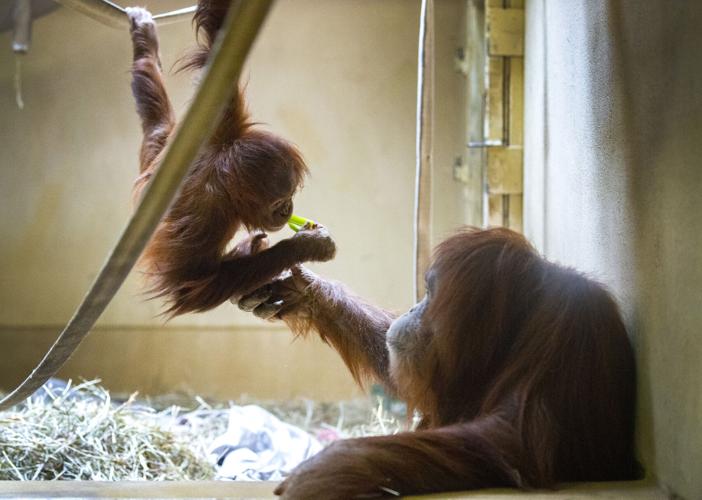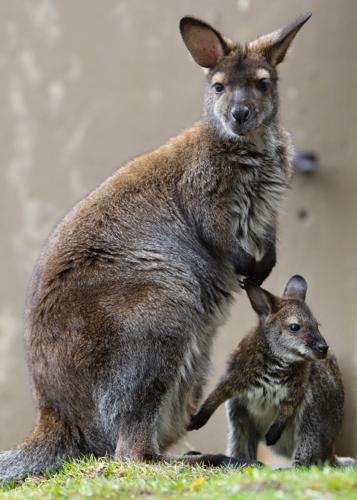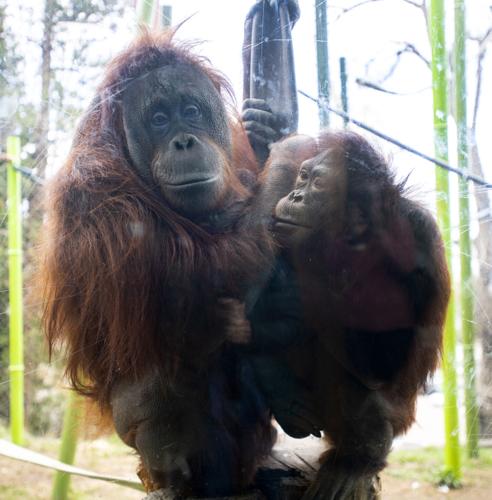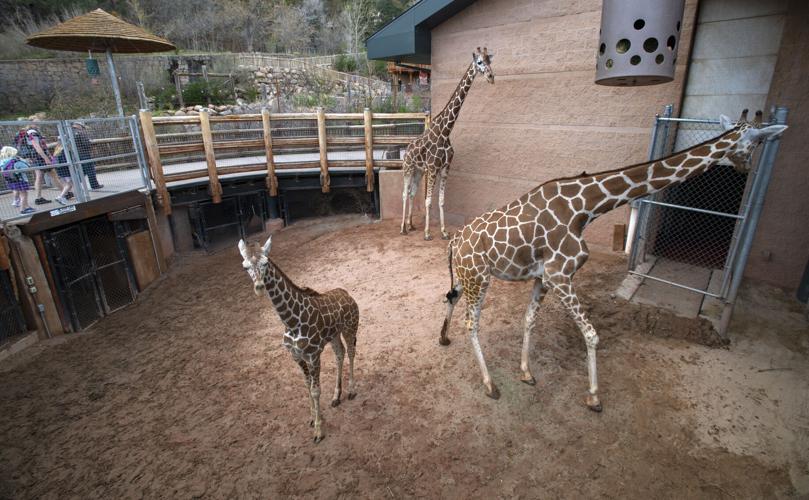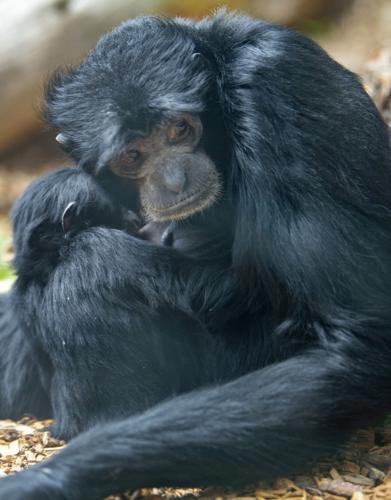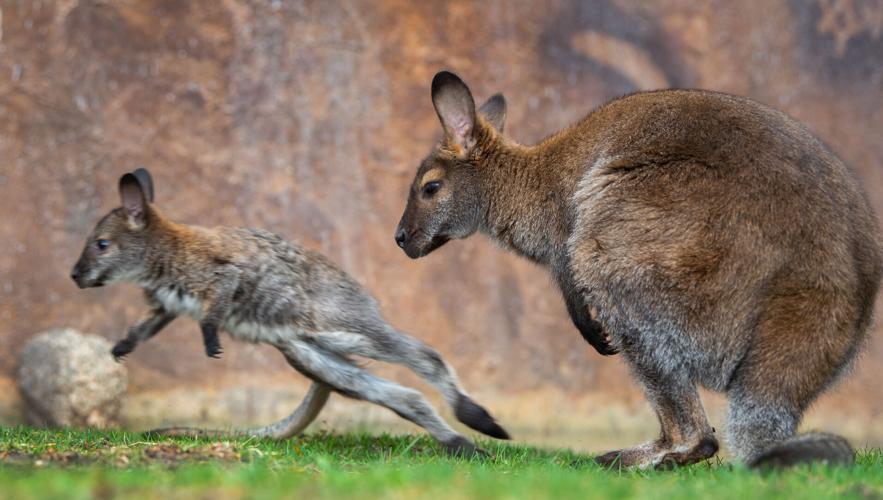Keeping Mother’s Day wild: How Cheyenne Mountain Zoo breeds and cares for moms and babies
At first glance through the thick glass, Eve, a Siamang ape with sleek black fur and gangly arms, simply seemed to be sitting on the floor of her enclosure, her back against the glass.
A closer look revealed an ape half the size of Eve nestled by her side, nuzzling for milk.
“She’s nursing,” Dina Bredahl, senior keeper for Primate World at Cheyenne Mountain Zoo.
“Eve, what makes her an exceptional mom, is that she only has one leg and she does everything she needs to do,” Bredahl said. Eve’s leg was amputated during an emergency surgery after a veterinary team found a life-threatening blood clot in her femoral artery.
Motherhood is not solely for humans. Each animal has a unique process of pregnancy and raising their young. And that process is treated intentionally and conscientiously at the zoo in order to conserve species and to help raise awareness about vulnerable populations, zoo officials said.
Eve’s 8-month-old baby, Rahsia, like many animals at the zoo, was born in the confines of human care as part of the Species Survival Plan for the endangered species of Siamangs.
Species Survival Plans are programs Cheyenne Mountain Zoo and other accredited zoos and aquariums use to track overall species population trends and genetic data of the animals in zoos in order to breed animals and preserve species, Rachel Wright, the zoo’s spokeswoman said.
Following Species Survival Plans helps avoid inbreeding and promote animal health, Wright said.
“We’re breeding animals here as a population that we may be able to release into the wild in the future,” said Jon Romano, the zoo’s head veterinarian.
Zoo staff monitor mothers and their babies throughout every step of the process, from breeding and pregnancy to raising young, Romano said.
In order for animal mothers to birth and raise their young successfully, creating an environment that mimics the wild in terms of diet, habitat and social dynamics is key, Romano said.
Eve isn’t the only mom raising a baby at the zoo. A ring-tailed lemur and red river hog gave birth just over a week ago, and many animal moms throughout the zoo are working to raise their young.
“For the most part, we try not to intervene,” Romano said. “Moms usually know what’s best and that’s no different here at the zoo. We do monitor moms and the babies pretty closely and we have basically triggers that will let us know if we’re going to get involved.”
In the case of Ember and Hadiah, a baby and mom orangutan pair, intervention was needed to help teach Hadiah how to nurse .
“With lots of work on our end, lots of work on Hadiah’s end, she did figure out nursing,” Bredahl said. “It was very rewarding to see Hadiah after some coaching and things like that want to hold Ember again.”
Smarter and more complex animals sometimes have less instinct involved when it comes to motherhood, Bredahl said.
But for prey animals like wallabies, motherhood is innate and rapid.
Wallabies are pregnant for 30 days and their young weigh less than a gram when born. Most of the baby’s growth process happens in the pouch, Bruce Dunbar, the keeper for Australia Walkabout, said.
Katt, a 9-month-old wallaby, bounded around the grassy slope of her open enclosure with her spring-like legs. She jumped toward a zookeeper feeding her unsalted almonds at the ledge of a short wall.
“Katt, as you as you can see, is very, very outgoing especially for her age,” Dunbar said. “They can be very skittish at this time, but she’s super brave.”
As the words left his mouth, Katt stepped too close to the edge of the wall and tumbled.
She popped back up and continued to explore.
“You can see she’s really curious,” Dunbar said.
Katt is not the only big personality at the zoo.
Over at the African Rift Valley exhibit, Msitu, a mother giraffe, tried to sneak a couple crackers from a treat bin. She stuck out her tongue between the enclosure’s wooden slats and inched the bin toward herself.
“We form really great relationships with these guys,” Amy Schilz, lead keeper for the exhibit, said as she fed crackers to the giraffes. “You can tell they’re not afraid of us.”
Schilz said positive reinforcement is vital to building relationships and training giraffes and other animals at the zoo. Training is also how keepers teach animal mothers and babies to take part in their health care, from ultrasounds to blood draws.
For zoo staff, getting to be a part of the animals’ growth, especially during motherhood, is the most rewarding part of the job.
“How many people get to go to work and see a giraffe face all day long?” Schilz said. “And babies — it’s just fun to see the process of them learning all new things and working with them in a positive way.”
Schilz takes her job’s mission seriously and strives to create awareness, provide education and promote conservation for animals like giraffes.
“You can’t be here and not fall in love with a giraffe,” Schilz said. “It’s just impossible.”
Humane society offers reward for info on person who threw kitten out of moving car
719-476-1623
@JessySnouwaert
Get OutThere
Signup today for free and be the first to get notified on new updates.




